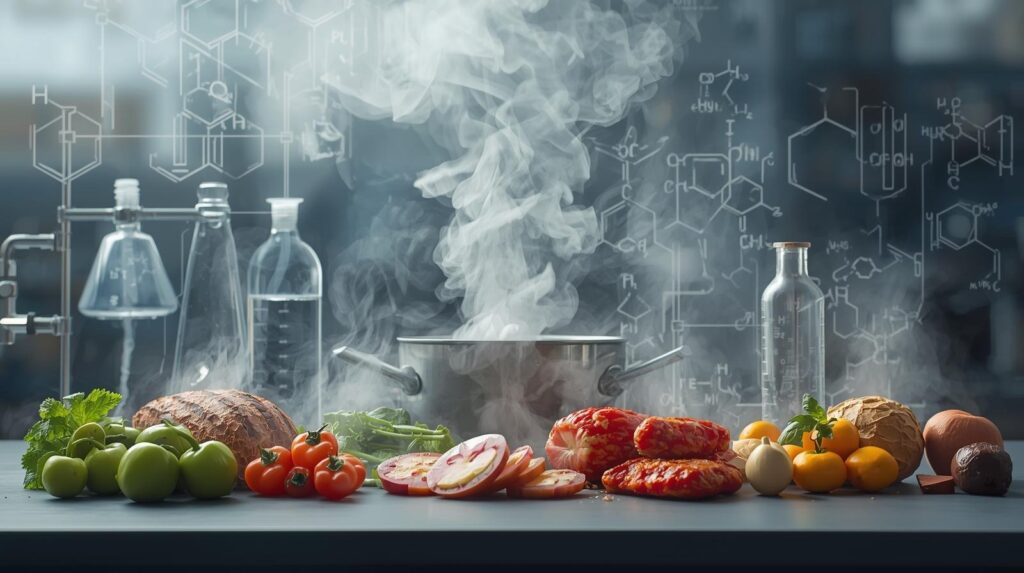Ever wondered why some cooking methods make your vegetables lose their color and nutrients, while others help preserve their goodness? That’s where food chemistry comes into play. This fascinating field explores how heat, pH levels, and chemical reactions influence the nutritional value of what we eat. From protein denaturation to vitamin degradation, every ingredient undergoes subtle changes during cooking that can either enhance or diminish its health benefits.
In this article, we’ll uncover how different cooking techniques affect nutrient retention, explore the role of heat transfer and enzymatic reactions, and share practical insights for preserving maximum nutrition in your meals. Understanding these scientific principles empowers you to make smarter choices in the kitchen turning everyday cooking into a delicious balance of nutrition and flavor.
Understanding Food Chemistry and Nutrient Retention
Food chemistry explores the composition and behavior of food components, such as carbohydrates, proteins, fats, vitamins, and minerals. It studies how these compounds react to temperature, moisture, and other external factors during cooking or processing. This field helps explain why certain foods change color, texture, or flavor when heated, and how these changes influence nutritional quality. The origins of food chemistry date back to the 19th century, when scientists began examining how chemical reactions affect food preservation and taste. Today, it forms the foundation of modern nutrition science, guiding healthier and more sustainable cooking methods.
Cooking is more than just heating food it’s a series of chemical transformations. Heat can improve digestibility and safety but can also lead to nutrient loss. Understanding these reactions allows us to optimize cooking methods for better nutrient retention and overall dietary quality.
The Role of Heat in Nutrient Preservation
Heat triggers various chemical reactions that influence the nutrients in food. Some nutrients, such as vitamins C and B, are sensitive to high temperatures, while others become more bioavailable after cooking.
How Heat Affects Nutrients
- Protein Denaturation: Heat unfolds protein molecules, making them easier to digest.
- Vitamin Degradation: Water-soluble vitamins like C and B-complex are easily destroyed by boiling or prolonged heating.
- Mineral Stability: Minerals like iron, calcium, and zinc remain relatively stable but can leach into water during cooking.
To preserve nutrients effectively, moderate heat and shorter cooking times are recommended. Techniques like steamingand microwaving are ideal for maintaining vitamins and antioxidants.
Enzymatic and Non-Enzymatic Reactions in Cooking
Food chemistry also involves two major types of reactions: enzymatic and non-enzymatic.
Enzymatic Reactions
These involve natural enzymes that catalyze chemical processes in food. For example, when fruits brown after cutting, the enzyme polyphenol oxidase reacts with oxygen. Cooking deactivates these enzymes, preventing unwanted color and texture changes.
Non-Enzymatic Reactions
These include the Maillard reaction and caramelization, both essential for flavor and aroma development.
- Maillard Reaction: Occurs between amino acids and sugars when food is heated, producing the appealing brown crust on bread and grilled meat.
- Caramelization: Happens when sugars break down at high temperatures, enhancing sweetness and flavor.
While these reactions improve sensory qualities, excessive browning may lead to nutrient degradation.

Influence of Cooking Methods on Nutrient Retention
Different cooking techniques affect food nutrients in distinct ways. Choosing the right method ensures both taste and nutritional value are preserved.
1. Boiling and Steaming
Boiling can cause nutrient loss due to leaching into the cooking water, especially for water-soluble vitamins. Steaming, however, keeps nutrients intact by minimizing direct water contact.
Example: Steamed spinach retains more folate and vitamin C compared to boiled spinach.
2. Baking and Roasting
These dry-heat methods enhance flavor and texture through browning but may reduce vitamin content. Baking carrots or tomatoes can increase antioxidant activity, making some nutrients more bioavailable.
3. Grilling and Broiling
These methods intensify flavor through charring but can generate harmful compounds like heterocyclic amines if overdone. Moderate heat and marination with herbs can minimize such effects.
4. Stir-Frying and Sautéing
Quick cooking with minimal oil helps retain vitamins and adds appealing texture. Using healthy oils like olive or canola further boosts the nutritional value of dishes.
Importance of Food Chemistry in Everyday Nutrition
Understanding the science of food reactions allows for smarter dietary choices. It helps identify which cooking techniques preserve the most nutrients and flavor.
Benefits include:
- Improved nutrient availability
- Enhanced flavor and aroma
- Better digestion and food safety
- Reduced risk of nutrient deficiency
Practical examples:
- Steaming vegetables instead of boiling them keeps their bright color and nutrients.
- Using acidic ingredients like lemon can protect vitamin C from oxidation.
- Soaking legumes before cooking shortens cooking time and preserves amino acids.
Challenges in Nutrient Retention
Maintaining nutrient quality during cooking can be difficult due to external and chemical factors.
Common challenges:
- Excessive Heat Exposure: Leads to loss of heat-sensitive vitamins.
- Oxidation: Occurs when air contact reduces antioxidant levels.
- Water Leaching: Causes soluble nutrients to dissolve into cooking liquid.
- Improper Storage: Exposure to light or moisture decreases vitamin potency.
Solutions:
- Use minimal water and shorter cooking times.
- Cover pans to reduce oxygen exposure.
- Incorporate raw foods when possible for maximum freshness.
Conclusion
In conclusion, food chemistry reveals how cooking transforms both the flavor and nutritional value of our meals. By understanding the chemical reactions that occur during heating, we can choose methods that enhance nutrient retentionand overall food quality. Techniques like steaming, stir-frying, and baking not only preserve vitamins but also elevate taste and texture. Embracing these insights empowers us to cook smarter and eat healthier every day. To dive deeper into the fascinating science of food chemistry, continue exploring research and practical cooking innovations that make nutrition truly come alive.





